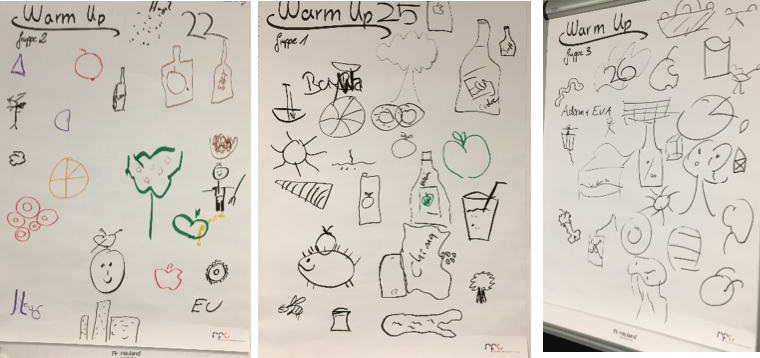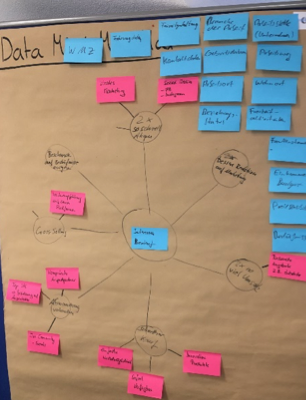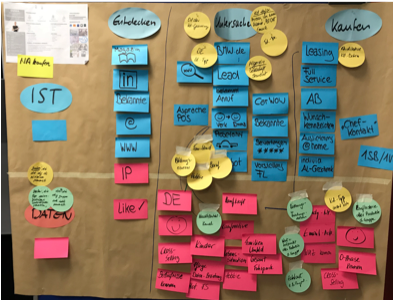
using data design thinking to obtain customer data
by andrea hickethier
Let’s be honest: Are all of your employees full of enthusiasm when it comes to collecting and processing customer data? Probably not. At least this is what we experience with the majority of customers that we work with. The good news is that data design thinking allows you to promote this highly competition-relevant topic in your company in a creative, innovative, and above all pragmatic way. And yes, working with data can be fun!
Data Design Thinking
What is data design thinking?
Data design thinking is a method that involves understanding, observing, defining perspectives, brainstorming, developing prototypes, and a test phase. The method is used to identify the customers’ needs and modulate creative solutions for data-driven challenges.
How can this be implemented in practice?
While the saying “Those who have the customer data have the power” is essentially correct, we believe that it is missing something. It’s not only about possessing the data, but rather about knowing which constructive actions can be performed with the data and can actually be implemented.
What is it like at your company? Do you have a clear target image as to which customer data your company needs in order to achieve its business goals? And how do you obtain this data?
Great things can be accomplished with the data design thinking method
All it takes is a few steps. We work on a total of five topics in a workshop together with our customers. The best thing is that the participants can take the results from the workshop and proceed straight to the implementation phase.
#1 Understand the design challenge
Define and formulate the design challenge. In practice, our customers often mention the following problem: “We don’t have a common understanding as to which customer data we need today and in the future in order to improve our business.” Use the "5-Why" method* in this phase to understand the principle of the design challenge. The following reasons are frequently given:
“We have lost sight of what our customer wants; our focus is on fast deals.”
“We include our contacts’ hobbies in the database. Does that even make sense?”
“The cost of an address is not made transparent to our employees.”
“The selling behavior has not yet been adapted to the changed customer behavior. What can I do?”
*Source: Saichi Toyota, founder of automotive manufacturer Toyota
#2 Observe and define a perspective
It’s time to put yourself in your customers’ shoes. We like to work with three different personas: Horst, Emma, and Max.
These stereotypes help our customers to quickly put themselves in the shoes of various types of customers and to consider how to solve the problem from the customer’s perspective. Ask yourself how you could get to know these three different types of customers better and how to better reveal their hidden results. To do this, use customer profiles, for example, which contain all relevant information. Once you have familiarized yourself with the personas, try to answer the following questions for each customer type in order to combine your observations and perspectives directly with the data context:
- “Which customer data do you need from Horst, Emma, and Max in order to acquire them more quickly than before while addressing the customer’s needs at the same time?”
- “Which customer data do you need from Horst, Emma, and Max in order for them to better react to marketing campaigns (e.g. higher conversion rate) while addressing the customer’s needs at the same time (e.g. avoiding information overload)?”
- “Which customer data do you need from Horst, Emma, and Max in order to generate twice as many sales while addressing the customer’s needs at the same time?”
- “Which customer data do you need from Horst, Emma, and Max in order to make the transaction more quickly while addressing the customer’s needs at the same time?”
- “Which customer data do we need in order to prevent customers like Horst, Emma, and Max from drifting to other competitors while addressing the customer’s needs at the same time?”
- “Which data do we need in order to perform cross-selling with the customers Horst, Emma, and Max while addressing the customer’s needs at the same time?”
- “Which customer data are you missing in order to process customer complaints from Horst, Emma, and Max more efficiently while addressing the customer’s needs at the same time?”
Use a mind map to enter your results for each customer.
#3 Develop ideas
During this phase, you can use the “customer journey” method to develop ideas as to which data you can realistically obtain from Horst, Emma, and Max at which step on their journey and how you can access it. The main focus here is on the needs and motivations of the respective customer types with respect to their personal data, preferences, etc. Note: The legal examination of the generated ideas does not take place in this phase. Use this method to specify the necessary customer data for six different use cases based on the questions listed in #2.
#4 Build prototypes
Create a prototype for the previously specified data collection and processing ideas independently of your current and existing structures.
#5 Test
Test the prototype, ideally in direct cooperation with your customers. Learn from the results and use them as a basis for the dynamic continuous development of your approach.
Data design thinking allows you to define a data collection strategy from the perspective of the customers and the company in your company in a short time. Data design thinking helps you to take a new approach to this topic. In the age of data, a clear data collection and processing strategy is indispensable for ensuring that companies can fully develop their potential.
This article is also published on LinkedIn.












